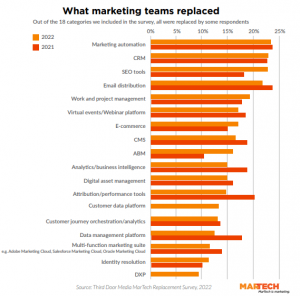As the number of gadgets in each household proliferates, contributor Asa Whillock discusses the benefits of marketing to people rather than devices.
 The rise in the number of devices used by individuals has created new challenges — as well as opportunities — for marketers wanting to target their audiences consistently. A typical household utilizes more than seven different devices, and the average person within that household uses about half of them.
The rise in the number of devices used by individuals has created new challenges — as well as opportunities — for marketers wanting to target their audiences consistently. A typical household utilizes more than seven different devices, and the average person within that household uses about half of them.
As a marketer, you want to have compelling, consistent and continuous conversations with your consumers. Perhaps your consumers have registered for your site from both their phones and their laptops, providing you with added insight into who those individuals are. However, if companies track, let’s say, 10 percent of their interactions with consumers this way, that means that nine out of 10 times, they aren’t communicating with them in a seamless way.
Today, there are two approaches to addressing this — one of which is the Google and Facebook approach. Using this method, we can say that we saw a Google or Facebook login on three different devices, and therefore, reasonably assume that all three of those devices belong to the same person, thereby increasing our advertising value and informing our strategy.
The challenge with this deterministic approach is that it’s oriented entirely around purchasing media with a specific company. Now it’s no longer the marketer’s customer, and you’re locked into buying media on their channel.
Another approach is probabilistic. In this scenario, you may not have logins connecting all of a user’s devices, but you can see that certain devices from the same IP address appeared on the advertising exchange.
While this approach is useful and doesn’t rely on media purchases, marketers are concerned about the confidence level with this method. Also, there is no concrete evidence confirming that just because they use the same IP address, or have similar HTTP header data, they belong to the same person.
The key here is to combine the best of both worlds: observances and algorithms. You also need the most deterministic data available to increase your confidence when tying devices to people — and to achieve confidence in your results while also being able to scale.
The benefits of advertising to real people
The benefits of marketing to people rather than devices are pervasive across a marketer’s role. The first area to look at is measurement. Advertisers are saying, “Give me confidence in the data that I have about the people who visit me, not just a pile of devices.”
When simply looking at impressions, the numbers can be misleading. Being able to accurately assess how you are reaching the people in your audience is critical.
Cross-device identification also helps advertisers detail a consumer’s path and understand how a two- or three-step journey across different devices changes how consumers interface with their brand.
For example, consumers who see display advertising on mobile and desktop may convert at triple the rate of consumers who only see desktop advertising. This not only affects your analytics, but also impacts how you might segment your audiences and what types of messaging you decide to put in front of them.
The alternative to cross-device identification is that the consumer feels that the brand doesn’t really know who they are. Imagine starting from square one with a merchant every time instead of one that recognizes you and caters to your preferences.
Being more aware of what a particular person is interested in — and then delivering a consistent experience across their devices — leads to a significantly improved outcome. People-based marketing can enable customization of all devices a consumer uses to consume your brand, allowing you to deliver relevant and personalized experiences on every visit.
The key is to expose content to people across all the devices they use, which can save companies from spending money on additional unnecessary ads. You may reach customers five times across the five devices they each use, and then cap further advertising if they’re not necessarily interested.
Perhaps the consumer has converted on one of those devices and you can suppress further ads or sequence ads about an additional offering. This provides opportunities to sell value-added services or other similar products.
This scenario has proven to be dramatically more effective for both the marketer and the consumer. In fact, we’ve found that advertising to consumers on two or three of their devices allows you to use half as many ad impressions to convert them.
Transparency in people-based marketing
People-based marketing is becoming a critical part of advertising. Marketers want to feel confident in their data and be able to speak directly to their consumers with competence and accuracy. However, transparency is a key component of people-based marketing.
Transparency is about empowering the consumer while simultaneously leveling the scales and empowering the marketer. Consumers want to know what kind of data is being used to represent them, as well as what devices are being connected with them or their activities. They not only want clarity regarding how their devices are linked, but also control.
Consumers want the option to say when they don’t want certain devices linked to the others. Transparency is a good practice that benefits consumers and marketers alike.
By utilizing a practice that is clear and well understood for the consumer, marketers can leverage sustainable and hygienic data for their organization that is gathered with the highest levels of consumer transparency and trust.
We’ve found that when you have this level of transparency and can educate the consumer, they become more comfortable with the experiences. Growing this confidence is perhaps the most critical part of the process, as it brings consumers on board with the business activities and improves their overall experiences with the brand.
As the advertising industry paradigm shifts from marketing to people instead of devices, it’s critical that advertisers stay ahead of the curve to provide their consumers with a better, more consistent and personalized content experience across digital touch points.
Some opinions expressed in this article may be those of a guest author and not necessarily Marketing Land. Staff authors are listed here.
Marketing Land – Internet Marketing News, Strategies & Tips
(107)
Report Post









